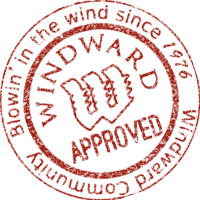Meet the Land

A Pine with a lot of character that we know as our "organizational tree".
Windward stewards 130 acres of oak, pine and fir forest, at an elevation of 2000 feet, on the southern slopes of Mt Adams.
In the rain-shadow of the Cascade mountain range, we receive about 26 inches of precipitation a year (compared to the approximate 60 inches that fall on Portland, OR), most of which falls between October and April.
This places us in the transition zone between the temperate rain forests of the western Cascades and the high grasslands of eastern Washington, between the alpine ecosystems of Mt Adams and the Mediterranean climate along the shores of the Columbia River.
Similar to Windward, the land we steward is itself on the edges of the dominant regional ecosystems, the very edges that give rise to diversity, growth and new potentials.

Frolicking in the golden summer grass at the edge of the plateau.
The acreage we call home contains many micro-habitats including oak woodlands, moist fir forests, seasonal creeks and Ponderosa pines reclaiming land recently burned in fire.
The coyotes serve as scouts on the property's perimeters, the deer nestle in a bit closer, favoring the buds of fruit trees in late winter, and the jays join us for lunch under the oak trees. The lichens and mosses, migratory birds and wildflowers, the forest's cover and the plateau's edge all combine to provide inspiration, solace and sanctuary.

A beautiful old Oak on the brink of leafing out in early Spring.
While diverse in species and micro-climates, due to the seasonal drought and the rocky, sloping soil, the land is marginally productive and poorly suited to row agriculture.
Our primary natural resource is the forest, a highly tuned solar collector that transforms the diffuse sun energy into raw materials (such as wood, acorns and grasses) that we can then utilize to form the foundation of our livelihood.

And old camping shelter amidst copses of Oregon White Oak.
The Klickitat people, who called home this region between Mt Adams and Mt Hood, were mobile hunter-gatherers, traveling in sync with the ripening of roots and fruits and the seasonal flushes of salmon in the rivers. This is to say that in order to support a stationary village year-round, this land needs to be supplemented with additional food producing species.
To do so, we are, year by year, creating a forest garden. Amidst the oak and pines, we are planting apples and pears, walnuts and chestnuts, and many other perennial food-producing plants.
On the forest floor, we are replacing the invasive annual grasses with deep-rooted native perennial grasses and introducing nitrogen-fixing alfalfa.

Moss, Lichen, and Fungi growing together on the side of an Oak tree.
We raise animals such as sheep and goats, ducks and pigs that are able to transform branches, grasses, acorns and bugs— valuable but not easily digestible resources we have in abundance-- into nutritionally dense foodstuffs such as milk, eggs and meat, as well as wool, hides, fat and bone that serve integral functions on a village homestead.
Our footprint on the land has evolved both intentionally and organically. The result is that intensely used spaces such as gardens and orchards, animal housing, community spaces, private living quarters, workshops etc are all concentrated on a central 5 acres of the property. Moving outward from this central area, land use intensity decreases.


Ponderosas Pines change characters through the changing seasons


